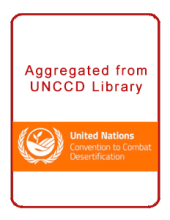Land Library Search
Through our robust search engine, you can search for any item of the over 73,000 highly curated resources in the Land Library.
If you would like to find an overview of what is possible, feel free to peruse the Search Guide.
/ library resources
Showing items 10 through 18 of 1081.Ecosystems and Biodiversity Facts and Figures # The IPBES Report (5) stated that “around 1 million animal and plant species are now threatened with extinction, many within decades, more than ever before in human history”.
This practitioner’s guide explains how to promote gender-responsive forest tenure reform in community-based forest regimes. It is aimed at those taking up this challenge in developing countries.
Meeting the Sustainable Development Goals requires drylands sustainability. Treating drylands as global environmental commons enables better tailored governance responses. Key nested governance elements for drylands involve setting goals, monitoring and delivering sanctions across scales.
Did you know that forests cover nearly 1/3 of land globally?
That’s 4.06 billion hectares.
In other words, there is around 0.52 ha of forest for every person on the planet.
In light of the urgency for policy action to address climate change, this report provides the first detailed global catalogue of targets and policies for mitigating greenhouse gas emissions in the Agriculture, Forestry and Other Land Use (AFOLU) sector.
The WWF’s Landscape Sourcing Report: Sustainable Business Using the Landscape Approach makes a case for the private sector to adopt landscape approaches to sustainably strengthen and increase cost effectiveness within their supply chains.
On 24 November 2020 the Land Inequality Initiative (International Land Coalition, OXFAM, Welthungerhilfe) launched its new research report "Uneven Ground: Land Inequality at the Heart of Unequal Societies", and a series of groundbreaking studies that reveal new insights and data proving that lan
Only if there is a fundamental change in the way we manage land can we reach the targets of climate-change mitigation, avert the dramatic loss of biodiversity and make the global food system sustainable.
The failure of rural economies to deliver decent work to their young people affects national economies, threatens political stability, nurtures extremism and causes socially and economically disruptive migration. Globally, youth are two to three times more likely than adults to be unemployed.


